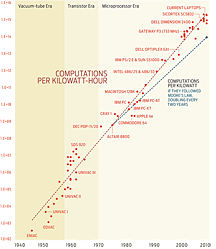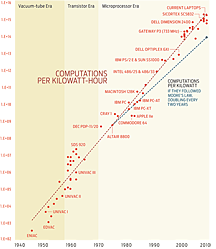The number of transistors on a chip has doubled about every two years for decades, a trend that is popularly (but often imprecisely) encapsulated as Moore’s Law. What is less well known is that the electrical efficiency in delivering computing performance began following a similar trend long before the microprocessor was invented.
The performance of desktop computers has doubled every 1.5 years, on average, since 1975, and in that time the number of computations per kilowatt-hour has grown about as quickly. But that measure of efficiency had also grown about that fast during the previous three decades, and even more rapidly during the vacuum-tube computing era and during the transition from tubes to transistors.
These are just a few of the conclusions drawn from a new study, ”Assessing Trends in the Electrical Efficiency of Computation Over Time,” prepared by me and my colleagues, researchers affiliated with Intel Corp., Lawrence Berkeley National Laboratory, Microsoft Corp., and Stanford University.
The main technology trends that have improved performance and reduced costs—at first better tubes, and then smaller transistors—also reduce power use, hence the similar improvements in computational performance and electrical efficiency, at similar rates, for such a long time. If these trends continue—and we have every reason to believe they will for at least the next 5 to 10 years—we can expect continued rapid reductions in the size and power requirements of computer-based devices. That should be especially welcome news for users of netbooks, smartphones, cameras, and other mobile devices.
The complete study is available from the Intel Web site [PDF 1.1MB].
About the Author
Jonathan G. Koomey, a former Intel researcher, is now a project scientist at Lawrence Berkeley National Laboratory, a consulting professor at Stanford, and a frequent guest on National Public Radio and the BBC. He shares the secrets of the numbers-crunching craft in his 2008 book Turning Numbers Into Knowledge: Mastering the Art of Problem Solving (Analytics Press).

